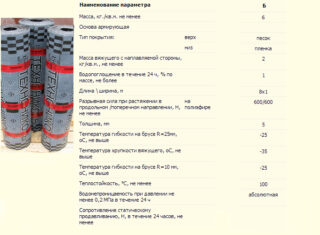Roofing material - roofing and waterproofing roll material. It is very easy to use, reliable, versatile and used in the construction of literally any building. But in order to take advantage of all the advantages of this material, it is necessary to choose a high-quality, for example, Technonikol roofing material.
Description and marking of material
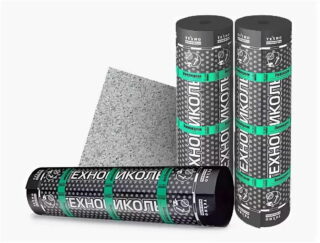
Roofing material is a multilayer material. It is based on building board, fiberglass, polyester fabric. A bitumen-polymer bonding agent is applied to the base on both sides. The last layer is sprinkling with mineral, stone, mica crumbs. The sprinkling can be on 1 or 2 sides or be absent altogether if this is a lining option for waterproofing.
The Technonikol company produces a huge number of different types of roofing material. In order for the consumer to evaluate the characteristics of the material he needs, he is marked. Each number or letter on the package provides specific information.
The first letter in the marking indicates the type of base:
- O - organic, for example, building board;
- E - polyester fabric;
- T - fiberglass, usually frame for greater rigidity;
- C - soft fiberglass;
- X - fiberglass.
The second letter indicates the type of surface:
- K - coarse-grained dressing, usually stone, gives the material greater wear resistance;
- M - fine-grained, such material is more flexible;
- P - film version without sprinkling.
The third letter indicates the type of back side:
- M - fine-grained dressing, if it is a cloth with sprinkling on both sides;
- B - ventilated layer;
- C is a self-adhesive layer; during installation, it is enough to simply warm up such material and immediately glue it to the surface.
In addition to the general classification, custom labeling is applied. The product line and brand are indicated here. For example, if the material is accurately attributed to bituminous roofing material, the designations should be interpreted as follows:
- P - the first letter simply indicates the type of material - roofing material;
- the second and third denote the type of front and back surface - coarse or fine-grained crumbs, self-adhesive;
- then numbers follow - the numbers indicate the density of the cardboard;
- there is also an additional marking with letters, for example, "C" means that the roofing material is sprinkled on top with colored stone chips.
Belonging to a particular line means that all representatives of this category have some common properties, for example, decorativeness or increased frost resistance.
Types of roofing material "Technonikol"
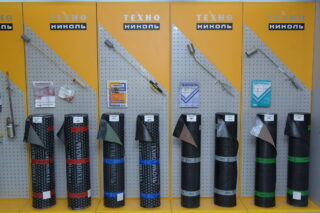
The company produces materials of almost all types and for any purpose.
- Fused - rubemast. It is based on roofing cardboard; a bitumen-polymer layer of increased viscosity is used for covering. A protective layer is applied to each side. Rubemast is warmed up before laying and glued to the surface.
- Glass-melt - a type of fused roofing material, in which glass fabric acts as the basis.
- Euroruberoid - this is how all types are often called, the basis of which is textile synthetic fabric. A bituminous mixture usually contains polymer additives that provide various additional properties. Often, the stone chips, which are sprinkled on the sheets, contain quartz. It increases UV resistance. Euroruberoid is distinguished by increased plasticity and water resistance.
- Roofing felt - bitumen mixture for impregnation includes additives of shale and coal. The surface is covered with fine mineral chips.
The material is chosen depending on the weather conditions of the region. And this includes ultraviolet indicators. In mountainous terrain, to cover the roof, you need to take a roofing material that is more resistant to this factor.
Material classes
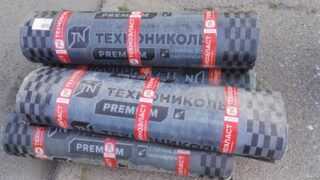
Technonikol offers roofing material at different prices and with different user characteristics.
- Economy - has an affordable price, quick installation and easy installation. The service life is 7 years.
- Standard - medium thickness, with optimal resistance to wind and rain loads. This is the most popular roofing felt from TechnoNIKOL.
- The business is high quality flooring serving for 20 years.
- Premium - is characterized by the longest shelf life - 20-30 years, and in the most severe conditions.
Each line includes products with some common properties and some differences.
In the Economy line, the Bikrost material is distinguished - a variant with a fiberglass or bitumen base with a profile filler.
The favorites in the Standard category are Linocrom and Bipol. They are distinguished by very high resistance to decay and mold due to their strong synthetic base.
In the line of Business Ecoflex stands out resistance to temperature changes and elasticity. The material is fused onto any non-combustible base.
In the Premium category, Technoelast DECOR roofing material attracts - with an original top coating. Colored stone chips improve UV resistance and create interesting effects. Technoelast FLAME STOP is popular, which has increased fire resistance.
Application area
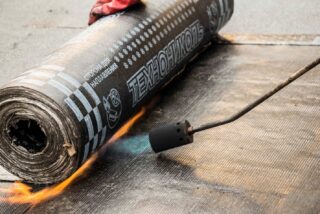
The characteristics of the roofing material from the Technonikol company make it possible to use it in a variety of works.
- Waterproofing - roofs, foundations, walls, floors, ceilings, any building structure. Waterproof, and retains moisture from both sides. When waterproofing the roof, floor and ceiling, roofing material protects the insulation, since the latter is very sensitive to moisture. When finishing the facade, the waterproofer prevents the penetration of water into the walls or cladding material.
- When building the foundation of a building, garage, stove, waterproofing is a necessary element. The foundation is in contact with the ground, and the latter necessarily includes some amount of water. The base material absorbs moisture to some extent. A waterproofer breaks the transfer of moisture from the foundation to the walls.
- Cushioning is a soft elastic roofing material, especially its special brands. Such a canvas is laid under various floorings, like metal tiles, profiled sheets. In this case, the waterproofer protects the structure from water and prevents mechanical damage to thin sheet materials. In addition, the roofing material perfectly dampens the sound: the sheathing covered with a canvas compensates for the sonority of, for example, a profiled sheet.
- Roofing - roofing felt with colored stone chips is most often used for these purposes. Most materials are not suitable for covering a flat roof or slope with a very low angle of inclination. With this design, water is retained on the roof and evaporates slowly. Such prolonged exposure to water usually causes damage to the roof.
On flat roofs, roofing material is laid in several layers, using both lining modifications and with stone chips.
Specifications
- The dimensions of the roll - the standard width of the web is 1 m, but 115 cm and 110 cm are also produced. The length of the strip in a roll can be 10 m and 15. It mainly depends on the weight of the roofing material. So, a roll of the RKP 350 brand includes 15 m and weighs 24 kg. And the heavier RKK 400 with stone chips weighs 25 kg, but the roll length is only 10 m.
- The thickness of the blade determines its strength and resistance to wear. The thickness of the lining is 2.8 mm.If roofing material acts as a roofing material, buy a sheet with a thickness of 3.8 mm.
- Density - varies from 115 to 190 kg per 1 m³.
- Consumption - an average of 1 m per 1 m². roofs. Depends on the size of the overlap.
If the roof is laid with roofing material, then pay attention to the attractiveness of the coating.
Installation work
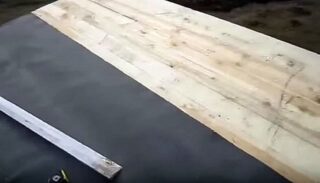
The scheme of application depends on the purpose. For example, roofing material RKP 350 "Technonikol" is a first-class waterproofing material used in the construction of foundations or wall decoration. And RKM 350 is a high-density roofing covering with mineral sprinkling. It is used for waterproofing roofs or flat pitches.
Basis of the requirement:
- Roofing material can only be laid on a solid crate. The latter must be treated with antiseptics and a primer before work.
- The concrete base is preliminarily cleaned of debris and leveled.
- The bituminous mastic is heated, applied to the canvas and rolled out over the surface. The material is leveled so that air pockets and bubbles do not form under it.
- If self-adhesive roofing material is used, no mastic is needed. Such a roll is heated in fragments and, after heating, is glued to the roof.
- The number of layers depends on the angle of inclination. On a slope with a slope of 45 degrees, roofing material is placed in 2 layers. On a roof with an angle of inclination from 20 degrees - in 3 layers.
The installation method also depends on the roof structure and weather conditions. Canvases can be laid along the slope, across, perpendicular to the previous layer.

